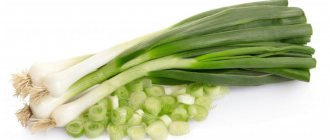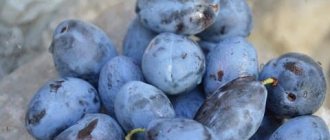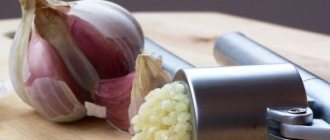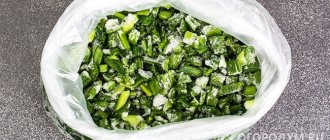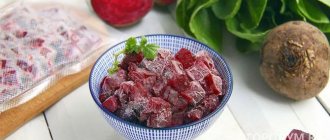Horseradish is one of the best natural antiseptics. It is used to prepare sauces, seasonings, snacks, pickled and salted vegetables, and cold soups. The product improves appetite, increases the body's defenses during epidemics of influenza and ARVI, is used in the treatment of sore throat, and alleviates gout, rheumatism, and kidney stones.
Freezing ensures the preservation of the beneficial properties of horseradish, improves the taste and eliminates the pungent odor of the root. In this article we will tell you how to freeze roots and leaves, how to properly store and use the preparations.
Is it possible to freeze horseradish for the winter?
Horseradish is the only plant that can withstand temperatures down to -90°C without losing its beneficial properties, so freezing it for the winter is not only possible, but also necessary. The advantage of this storage method is the loss of the pungent odor, which forces housewives to suffer in the process of grinding the roots on a grater. The second advantage of freezing a product is an increase in taste.
Horseradish is characterized by high nutritional value - the leaves and roots contain B vitamins, vitamin C, E, K and PP, potassium, calcium, sodium, magnesium, sulfur, phosphorus, iron, copper, fluorine, zinc.
Reference. 100 g of product contains 61.1% of the daily requirement of ascorbic acid.
Is it possible to freeze horseradish
Horseradish is usually salted or used in various marinades. The famous Russian sauce is prepared on its basis - horseradish, gorloder, horseradish, ogonek. Each region has its own name. The essence is the same - the result is a very aromatic, spicy tomato with a fresh taste. No vinegar or preservation. Aspirin is occasionally added. The pungent root itself is an antiseptic. It perfectly kills bacteria and prevents fermentation.
Housewives often ask whether horseradish can be frozen. In fact, this is one of the best ways to prepare roots and greens. The product retains its properties completely. At the same time, the aroma weakens slightly. It does not irritate mucous membranes.
You can freeze horseradish roots and leaves in the freezer.
Do you prepare horseradish leaves for the winter?
Not really
Is frozen horseradish healthy?
The root contains 11 vitamins. Among them there is especially a lot of choline. Microelements are present - aluminum, zinc, fluorine, chromium and more than a dozen more. There are macroelements - potassium, sodium, phosphorus, chlorine, sulfur, silicon. In addition, there is a huge amount of plant phytoncides, organic acids, and essential oils. If frozen correctly, horseradish will retain up to 99% of all these substances.
Useful properties of garden horseradish:
- increases immunity;
- kills viruses, bacteria, helps fight flu and colds;
- cures runny nose;
- speeds up metabolism;
- increases appetite;
- is a source of vitamins and minerals;
- relieves pain from rheumatism;
- returns masculine strength;
- improves liver function.
The product can be frozen in the freezer exclusively for medicinal purposes. But they are used internally, externally, used for the prevention and treatment of colds, strengthening the immune system, beauty and health. Another product that is recommended to be frozen for the winter is fresh fern.
Can horseradish do any harm?
A burning product will cause harm to health in case of any diseases of the digestive system. Horseradish contains irritants. Possible exacerbation of ulcers, gastritis, colitis. Another contraindication is liver disease. Do not use during pregnancy or breastfeeding. The presence of any inflammatory processes requires prior consultation with a doctor.
Horseradish is contraindicated in some cases for oral administration, but no one forbids inhaling its aroma. Inhalations will help cope with runny nose, colds, and coughs.
Selection and preparation of horseradish for freezing
Juicy roots without dark spots, damage and signs of rotting at the age of 2-3 years are suitable for freezing. The leaves should be fresh, green and crisp. When cut, the roots should be milky or white.
The roots are soaked in cold water for 1-2 hours to remove dirt and make cleaning easier. The washed roots are brushed and the skin is cut off with a sharp knife or vegetable peeler. To minimize exposure to air, place the peeled horseradish in a bowl of ice water. This will preserve the aromatic substances of the plant. Then the roots are dried with a paper or waffle towel and frozen.
Horseradish leaves are thoroughly washed under the tap, placed between two towels or dried in a salad and herb dehydrator to remove water.
The photo shows horseradish roots and leaves.
Contraindications for use
No matter how useful horseradish may seem, not every body is able to perceive it normally. It is not recommended to eat it for those who have at least some problems with the intestines, digestive tract, etc. It is also not recommended to use horseradish for cosmetic purposes for those who have oily, dry or problematic skin. Even if the skin is perfectly healthy, you should not leave horseradish on your face for a long time - it can cause burns and damage to your facial skin.
Eating horseradish is contraindicated:
- Pregnant and breastfeeding women.
- People with individual intolerance to the product.
- People with acute intestinal and gastrointestinal disorders.
- With increased acidity in the body.
Freezing methods
There are several methods of freezing, depending on the purpose of use in cooking. The roots are frozen whole, in pieces, or grated.
Entirely
Roots without peel are placed in plastic bags of 3-4 pieces. or wrapped in cling film. Then place it in the freezer compartment of the refrigerator.
Pieces
The peeled roots are cut into 2-3 cm pieces and placed in freezer bags or food containers. Thick bags with a zip lock are ideal - they do not allow air or foreign odors to pass through.
Containers are sealed with lids or wrapped in cling film. The preparations are placed in the freezer. After 3-4 hours, take out the workpiece and shake it - this way the pieces will not stick together into one mass.
This is interesting:
Features of pickling cucumbers for the winter in a barrel.
Recipes for canned watermelons for the winter without sterilization.
Grated
The method of storing grated horseradish is labor-intensive, but you will already have a ready-made component for preparing dishes. Peeled and soaked in cold water, horseradish is grated by hand on a fine grater or a more gentle method of grinding is used in a blender or meat grinder.
To protect the eyes and respiratory organs, wear a respirator, if available, or a cotton-gauze bandage, and construction glasses.
A plastic bag is pulled over the outlet of the meat grinder so that the chopped horseradish falls directly into it. Thus, it is possible to minimize the release of odorous vapors into the air.
Prepared horseradish is packaged in freezer bags or trays.
Advice. Mix chopped horseradish with grated apple and lemon juice. Use it as a snack or dressing.
Leaves
Prepared horseradish leaves are placed in bags whole or cut into strips. This preparation enriches the taste of meat dishes, soups, appetizers, and sandwiches.
How to use frozen horseradish
It is important not only to freeze the product, but also to use it. Then you won’t have to empty the freezer in the spring and throw away the food. Let's talk about the main methods of using horseradish. Let's share some tricks.
In cooking
Frozen leaves are used for marinades, less often soups, sauces. Much more interesting are the ways to use the roots. It is impossible to imagine Russian cuisine without them. Grated horseradish was served with lard, jellied meat, and used for various dishes.
Application options:
- cold sauces. Mix with garlic, sour cream, sometimes boiled beets, various herbs;
- soups. Add to okroshka, beetroot soup, add to borscht, pickles, kharcho when serving;
- snacks. Horseradish is used to complement a meat plate, sliced lard, and sausage. It is served in a separate gravy boat for spreading on bread;
- adding to salads. It goes especially well with meat ingredients, pickled mushrooms, cucumbers, and boiled beets. A vinaigrette with grated horseradish turns out to be interesting.
Thawed horseradish becomes less spicy, low temperatures make the taste more tender, and the pieces soften. You can add more than the recipe calls for.
In folk medicine
Horseradish is used as a general strengthening product. For maximum preservation of nutrients, we recommend freezing at the lowest temperatures. Do not remove from the freezer in advance.
How to use:
- just for food. See culinary options above;
- mixtures. Combine with garlic. Sometimes the ingredients are topped with honey and vegetable oil. Used daily;
- juice of rhizomes, leaves. It can also be frozen. Drink a teaspoon to restore blood and cleanse the liver;
- with milk. Add 1 tsp to a glass of warm drink. grated root. Drink for coughs, sore throats, and other colds.
It is believed that the juice prevents the formation and growth of tumors. You can freeze it in ice cube trays. The only problem is the roots; the leaves are quite hard and contain little moisture. You will need to grind and squeeze out a considerable amount.
Application
Horseradish is widely used in cooking for the preparation of:
- cold soups: botvinya, okroshka, mushroom, vegetable, borscht;
- gravy for meat and fish;
- sauces with sour cream, yogurt, mayonnaise with the addition of lingonberries, cranberries, dill, parsley;
- homemade alcoholic drinks (hrenovukha);
- savory appetizers for meat with tomatoes or beets;
- marinades, pickles;
- spicy salads.
A culinary masterpiece called “khrenovina”, “khrenoder” has long been loved by fans of savory snacks. Other names for this seasoning are “Ogonyok”, “Russian adjika”. The appetizer is prepared from tomatoes, garlic and horseradish root twisted in a meat grinder. The finished mixture is salted to taste, seasoned with vinegar, black or red ground pepper. The proportions are arbitrary, depending on the desired spiciness.
A spicy sauce is prepared with horseradish leaves.
For this recipe take:
- 300 g fresh or frozen horseradish leaves;
- 1 kg of tomatoes;
- 6-8 cloves of garlic;
- sugar and salt - to taste.
All components of the sauce are ground in a meat grinder and sugar and salt are added. The resulting mass is placed in clean 250 ml jars and placed in the refrigerator for storage for three months.
How to freeze the root
One of the benefits of freezing horseradish root is that it becomes less pungent. Now it’s just a nice spicy supplement with a bunch of vitamins and microelements, and not a test for the eyes and stomach.
Frozen horseradish recipe:
- Choose whole, healthy-looking roots. Plants that are 2-3 years old are the most delicious. They are best stored.
- Fill the root with water and let it sit for a couple of hours to loosen the dirt. Use a brush if the fruit is too dirty.
- Peel the skin with a knife or potato peeler.
- Rinse and dry.
- Cut the root into cubes with an edge of 1-1.5 cm.
- Freeze all the cubes by placing them in an even layer on a flat plate. After 2-4 hours, remove them from the freezer and distribute them into storage bags. This way they won't stick together.
- Make convenient portions so that one package goes for one dish.
- Thawed horseradish cannot be stored for a long time, and repeated freezing is even more harmful to the product.
Miss Purity magazine recommends not storing horseradish and other fruits for more than one year, but rather eat frozen ones in the first months, without waiting for spring. This way you will get more benefits from the products.
Option with grated horseradish:
- Grind the peeled and washed fruit or pass it through a meat grinder, depending on what consistency you like best.
- Spoon the mixture into small portion packets.
- Place in the freezer immediately. The result was a preparation for sauces and salads.
- Grated horseradish is sometimes mixed with lemon juice and grated apple and used as a dressing or appetizer.
We recommend: How long can you store potatoes in the refrigerator?
Tip Protect your eyes from caustic horseradish by placing a collection bag on the meat grinder.
Horseradish is a natural antibiotic, antiviral, appetite enhancer and gastrointestinal stimulant. Add some defrosted horseradish to your winter menu to always feel healthy and energetic.
Is it possible to freeze bananas and why is it necessary?
Bananas are perishable foods. If transportation, temperature and storage conditions are incorrect, the substances contained in this product interact with the environment, causing its deterioration. For longer storage, freezing technology is used, which stops putrefactive processes.
The fruit contains minerals, antioxidants, vitamins B1, B2, B6, C and various trace elements (potassium, calcium, iron, magnesium, fiber, fructose, beta-carotene).
Proper freezing allows you to preserve the beneficial substances and properties of the product for a long time.
Incorrect storage temperature leads to rapid ripening or overripening, which affects the appearance (darkening, spots appear), consistency (becomes loose), and taste. If bananas are frozen correctly, spoilage of the product is excluded.
In addition, storing bananas in the freezer allows you to use them in the preparation of various dishes and drinks, regardless of the season.
Should bananas be frozen? Poll Options are limited because JavaScript is disabled in your browser.
Storage period and conditions
It is important to know not only how to freeze horseradish, but also how to store it in the freezer. The timing is the same, regardless of what is frozen (leaves, roots) and how (whole, chopped or grated):
- The temperature in the freezer should be stably maintained no higher than -18 degrees. Under such conditions, the maximum shelf life at the frozen stage is 10-12 months.
- It can also be stored at a temperature of -5 degrees. Then the maximum period will be six months.
- If kept at 0 degrees, it can be stored for no more than four months.
Pie
Useful preparations allow you to prepare a layer cake with frozen berries. There are many different recipes. For the simplest one, you will need 500 g of berries and the same amount of dough. You also need sugar (1/2 cup), starch (3 tbsp) and an egg. Puff pastry can be purchased ready-made. It must be divided into 2 parts. One of them needs to be rolled out to the size of a baking sheet. Grease the container with oil and transfer the dough.
The berries must be mixed with sugar and left for 15 minutes. Then you need to remove the liquid and add starch. Now you can add the filling. After this, we lay out the second rolled out layer on which to make cuts. The baked goods are treated with egg. Place the pie in the oven for 30 minutes, which must be preheated to 200 degrees. Do not immediately remove the cake from the mold, let it sit a little. The result is a delicious dessert that will be an excellent addition to any tea party.
Is it possible to store horseradish root in the freezer?
Horseradish is quite suitable for freezing. You can store it in the freezer for up to one year without worrying about its taste and nutrients. This method has several advantages:
- the root vegetable remains fresh and aromatic;
- it can be used to prepare any dishes;
- defrosting is very simple, often not required;
- vitamins and other valuable components are not destroyed;
- there is no contact with air and light;
- Even if you're short on space, you can save space by finely chopping or grating the rhizomes for freezing.
There are practically no disadvantages. Although, during slicing and especially chopping root vegetables for freezing, a large amount of caustic substances are released into the air. Therefore, it is necessary to use personal protective equipment (mask, goggles) and a tight bag.
Does horseradish lose its properties after freezing?
Horseradish does not lose any beneficial substances after freezing. This is one of the few root vegetables that can withstand even shock temperatures down to -90 degrees. Moreover, experienced housewives note that after freezing its taste becomes less pungent.
After defrosting at room temperature, horseradish retains all its beneficial qualities. It is used to prevent respiratory diseases, cancer pathologies, eliminate swelling, jaundice, headaches and many other health problems.

